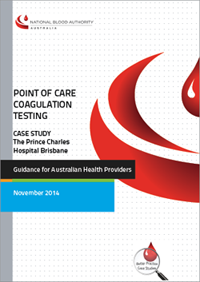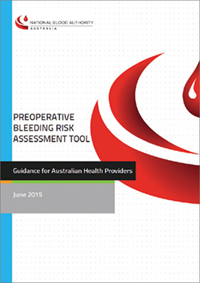Objective 3. Promote the safe and efficient use of blood and blood products
In 2014-15, the NBA continued its intensive programme to promote the safe and efficient use of blood and blood products. This includes the delivery of a range of key reference material and accelerated supporting implementation activities in relation to reducing wastage and improving fresh blood use based on the NBA developed PBM Guidelines.
Reference Development
In 2014-15, the NBA focused reference development on progressing Modules 5 and 6 of the PBM Guidelines and new National Haemophilia Guidelines. The NBA also commenced a project, approved by JBC, to pilot an enhanced review process for Module 1 of the Patient Blood Management Guidelines. The new process will seek to optimise the efficiency and timeliness of the Patient Blood Management Guideline updating process.
PBM Guidelines
Over 102,000 copies of the PBM modules 1 to 5 have been either issued in hard copy or downloaded in over 60 countries. They provide evidence based guidance on optimisation of the patient's own blood, non-transfusion strategies to minimise blood loss and bleeding and strategies to manage anaemia. In 2014-15 the NBA published the PBM Guidelines: Module 5 Obstetrics and Maternity and progressed the development of Module 6 Neonatal and Paediatrics. Module 6 is expected to be published in early 2016.

PBM Guidelines publication covers
National Haemophilia Guidelines
The NBA has continued to work closely with AHCDO during 2014-15 to progress the new National Haemophilia Guidelines to replace the existing Clinical Practice Guidelines for the Use of Recombinant and Plasma - Derived Factor VIII and Factor IX products published in 2006. The revised guidelines will provide more comprehensive, patient-focused guidance to support the management of patients with haemophilia. The guidelines are due to be released for public consultation in October 2015 and it is expected that the revised guidelines will be published in 2016.
Implementation
A core element of ensuring reference material influences the safe and efficient use of blood and blood products are activities that support their implementation. In 2014-15, the NBA continued its focus on activities to support implementation of measures to reduce wastage of blood and improve appropriate use through PBM as defined in the JBC approved National Blood and Blood Product Wastage Reduction Strategy 2013-2017 and the National Patient Blood Management Guidelines Implementation Strategy 2013-2017. The strategies address a significant proportion of requirements identified in the 2010 Australian health ministers' Statement on national stewardship expectations for the supply of blood and blood products. Although the strategies differ in terms of specific outcomes, the strategies share key common elements including the development of:
- best practice tools
- promotional and communication activities
- supporting education and training
- data to support implementation of improvement.
Best practice tools
In 2014-15 the NBA added further best practice tools to support health providers to implement improvements in the management and use of blood and blood products, including publication of the:
- PBM Guideline Companion which explains PBM concepts and interventions. It has been designed so that it can be used as a whole or in parts as brief, individual information sheets.
- Preoperative Bleeding Risk Assessment Tool – Guidance for Australian Health Providers in June 2015. The tool is intended to assist healthcare professionals in assessing and managing the risk of bleeding a preoperative patient.
- Red Blood Cell and Massive Transfusion Protocol clinical audits. The audits support quality assessments.
- Iron Product Choice and Dose Calculation Guide for adults.
The Patient Blood Management website pages have also been reviewed and amended to improve accessibility.
Promotion and communication
In 2014-15 the NBA continued its aggressive promotion and communication campaign to increase awareness of the need to improve clinical practice and inventory management in relation to blood products. This included representation and promotional and educational activities at a range of clinical and health sector conferences and events, including the following:
- 2014 Annual Scientific Meetings of the Haematology Society of Australia and New Zealand, Australian & New Zealand Society of Blood Transfusion and the Australasian Society of Thrombosis and Haemostasis (HAA), Perth, October 2014
- Royal College of Pathologists Update 2015, Melbourne, February 2015
- Australian Private Hospitals Association (APHA) 34rd National Congress, Melbourne, March 2015
- Royal College of Obstetrics & Gynaecologists (RCOG) World Congress, Brisbane, April 2015
- Australian and New Zealand College of Anaesthetists (ANZCA) Annual Scientific Meeting, Adelaide, May 2015.
The NBA also sponsored a number of stand-alone events designed to improve awareness and understanding of improvements required in the management and use of blood and blood products.
- The NBA engaged the ACSQHC and Queensland Department of Health to co-sponsor a National Blood Symposium held in June 2015 at the Brisbane Convention and Exhibition Centre.
- The Symposium was attended in total by more than 370 health professionals and focused on supporting the implementation of Standard 7 Blood and Blood Products of the NSQHS. The overarching theme of the Symposium was "showcasing excellence" in implementing Standard 7. A key feature of the Symposium was the opportunity for delegates to actively participate in numerous topical workshops run by experts in their field. The inaugural National Blood Awards for Excellence in the Management of Blood were also held in conjunction with the Symposium. A total of 12 awards were presented to health professionals and organisations for outstanding achievements associated with implementing the Standard and a range of initiatives demonstrating exemplary achievements.
- In 2014-15 members of the NBA CRG presented on the PBM Guidelines at numerous international, national and local meetings.
- The NBA undertook an awareness-raising campaign in conjunction with a number of jurisdictions and health providers aimed at highlighting the high level of blood product wastage and measures that could be taken by health services and individual staff members to reduce this wastage. This campaign included detailed health service specific reports on their discard levels benchmarked against similar facilities and a range of promotional items such as posters and swing tags for blood bags aimed at allied health and nursing staff on the wards. The rate of discards (as a percentage of issues) for red cells decreased from 5.1 per cent in 2013-2014 to 3.9 per cent in 2014-2015 and platelet discards decreased over the same time from 17.8 per cent to 14.2 per cent.
The NBA promotes improved inventory management and appropriate clinical use of blood and blood products at a range of relevant national forums.
An important addition to this programme in 2014-15 was the Rural Medicine Australia 2014 conference in Sydney. The conference presented rural doctors with an opportunity to gain skills, exchange knowledge and network in a rural medical practice setting. The NBA was pleased to be part of this event, including sponsoring two speakers in the programme (Dr Lilon Bandler and Dr Amanda Thomson). Senator the Hon Fiona Nash, Assistant Minister for Health, also attended the event.
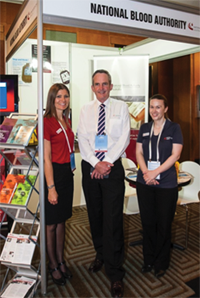
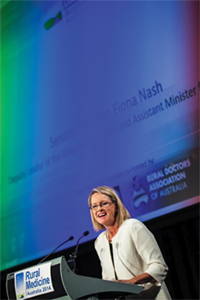
Left image: The NBA stand at Rural Medicine Australia Conference 2014. Left to right: Lyndsay Wall, Leigh McJames and Donna Cassoni.
Right image: Senator The Hon Fiona Nash, Assistant Minister for Health, speaking at Rural Medicine Australia Conference 2014.
Rural Matters - Gippsland Acture Care Symposium
The NBA is committed to engaging with health professionals to promote and improve patient outcomes and for the development of education, treatment and resources with a wide range of stakeholders, including the rural health care sector.
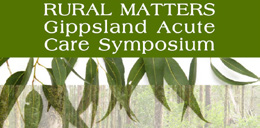
As such, the NBA was a Silver sponsor at the Rural Matters Conference, Gippsland Acute Care Symposium held on 27 and 28 November 2014 at the Federation University Gippsland Campus, Churchill.

The programme of this event looked at the management of acutely ill patients, with a focus on issues faced by health professionals in the rural setting. Key issues covered at the event included:
- Obstetric emergency management in a rural setting
- Family presence at resuscitations
- Paediatric advanced life support
- Management of snake bites in a rural setting.

The NBA was proud to be part of this event as it provided a first-hand opportunity to promote the messages of patient blood management, inventory management, blood systems and general knowledge of blood and blood products directly to delegates in a rural setting.
The 2015 National Blood Symposium
The 2015 National Blood Symposium: Showcasing Excellence – Standard 7, Blood and Blood Products was a major event in 2015 for the blood sector.

The NBA stand at the 2015 National Blood Symposium
The Blood Symposium was co-sponsored by the NBA, Queensland Health and the Australian Commission on Safety and Quality in Health Care. This event built on the inaugural National Blood Symposiums in 2013 and included a series of workshops covering topical issues of interest to Australia's blood sector including:
- Accreditation – implementing Standard 7: Blood and Blood Products
- Patient Blood Management
- Safe Transfusion tools and resources
- Communicating with patients
- IT solutions to support safety and quality.
In addition to the workshops, the Symposium program included the official launch of Module 4 (Critical Care) and Module 5 (Obstetrics and Maternity) of the National PBM Guidelines and a question and answer session with prominent speakers on blood-related topics.

Workshop presentation at the 2015 National Blood Symposium
With an attendance of over 370, an interactive poster display and ten key stakeholder exhibitors, the 2015 National Blood Symposium was a unique event for delegates from a range of professions (e.g. clinicians, laboratory technicians, government, educators) to network, share personal experiences and showcase initiatives in the blood sector. The facilitator for the event was Ms Bernie Hobbs.
The 2015 National Blood Symposium was also an opportunity to celebrate excellence and outstanding achievements in the sector with the implementation of Standard 7. This celebration was marked by an Awards Ceremony, where the inaugural National Awards for Excellence in the Management of Blood were presented.

National Award of Excellence in the Management of Blood
The inaugural National Awards for Excellence in the Management of Blood were presented at the Gala Dinner Awards Ceremony. The recipients are listed below by category:
Excellence in implementing a PBM program
- The Royal North Shore Hospital, Sydney
- Ms Bronwyn Pearse, Clinical Nurse Consultant, Blood Management,
The Prince Charles Hospital, Brisbane - The Sir Charles Gairdner Hospital, Perth
Excellence in implementing an Inventory Management program
- The Royal Melbourne Hospital
- The Royal Children's Hospital, Melbourne
Excellence in the governance of blood and blood products
- The King Edward Memorial Hospital, Perth
- The Fiona Stanley Hospital, Perth
Excellence in a Public/Private Health Sector Collaboration
- Albury Wodonga Health
- BloodMove Program – SA Department of Health & Ageing and SA Pathology Transfusion Service
Excellence in implementing NSQHS Standard 7 – Blood and Blood Products
- The King Edward Memorial Hospital, Perth
- Ms Ann Graham, Transfusion Clinical Nurse Consultant, John Fawkner Private Hospital, Melbourne
Education and Training
National Blood Sector Education and Training Strategy
With the publication of the PBM Guidelines and the implementation of Standard 7 Blood and Blood Products, the demand for supportive education, training and information resources has risen.
In 2014-15, the NBA progressed the National Blood Sector Education and Training Strategy 2013-2016. The strategy outlines a plan to work with current education and training providers to address the growing demand for high quality, well-tailored education, training and health promotion materials to support the implementation of evidence-based practice and attainment of health service accreditation under the new standards.
The National Blood Sector Education and Training Strategy supported the establishment of the National Education and Training (NEAT) Committee. The last committee meeting was held on 18 March 2015 where members discussed the development of the Key Learning Areas Framework, assisted in setting Education priorities for the sector and contributed to discussion following a presentation on the consumer engagement strategy. The Key Learning Area Framework highlights the knowledge and skills required for a patient journey where treatment with a blood product may be needed. The framework will be finalised for endorsement by the full committee and JBC in 2016.
BloodSafe eLearning Australia
BloodSafe eLearning Australia (BEA) is funded by all Australian governments. The online site offers a range of courses relating to clinical transfusion practice including PBM, blood specimen collection and product handling. The suite of courses has proved to be very popular with 310,848 registered users and 73,854 new registrations in 2014-15. Uptake by the target audiences has seen course completions per month go from 10,500 per month in 2013-14 to 14,600 during 2014-15.
Analysis of total completions per course indicates that Clinical Transfusion Practice continues to have the highest completion rate, averaging 54 per cent of all course completions per year.
The following enhancements were made to BloodSafe eLearning Australia during 2014-15:
- Six new modules were released - learning modules based on the PBM Guidelines – Module 3 Medical including specialist topics for Cancer, Cardiac, Chronic Kidney Disease, Chronic Transfusion and Gastrointestinal.
- BloodSafe eLearning Australia systems were transitioned onto the NBA hosting infrastructure.
- All courses released prior to 2013 were refreshed to mobile device friendly software. This included peer review of the courses. All courses are now in the same style and mobile device friendly format.
- A new Learning Management System was implemented.
- The Nous Group completed a review of BloodSafe eLearning operations to identify a best practice model and future funding options.
- An online fulfilment facility for hospitals to order a limited supply of colour course and promotional material was implemented.
The excellent work of BloodSafe eLearning was also recognised with two awards:
- Silver Award – Best eLearning Model LearnX Impact Awards
- Honourable Mention eLearning– Internal eLearning Awards
National Safety and Quality Health Service Standards
As part of the National Health Reforms, the ACSQHC (Commission) has developed the NSQHS Standards. These standards are intended to drive improvement in safety and quality for patients. They also provide a clear statement of the level of care consumers can expect from health services. Accreditation against the standards commenced in January 2013. The NBA is committed to supporting health service organisations to meet the requirements under Standard 7 Blood and Blood Products. During 2014-15 the NBA worked with the Commission and other stakeholders in the first phase of the process to review Standard 7 in support of the development of the next edition of the Standards, scheduled for release in 2017.
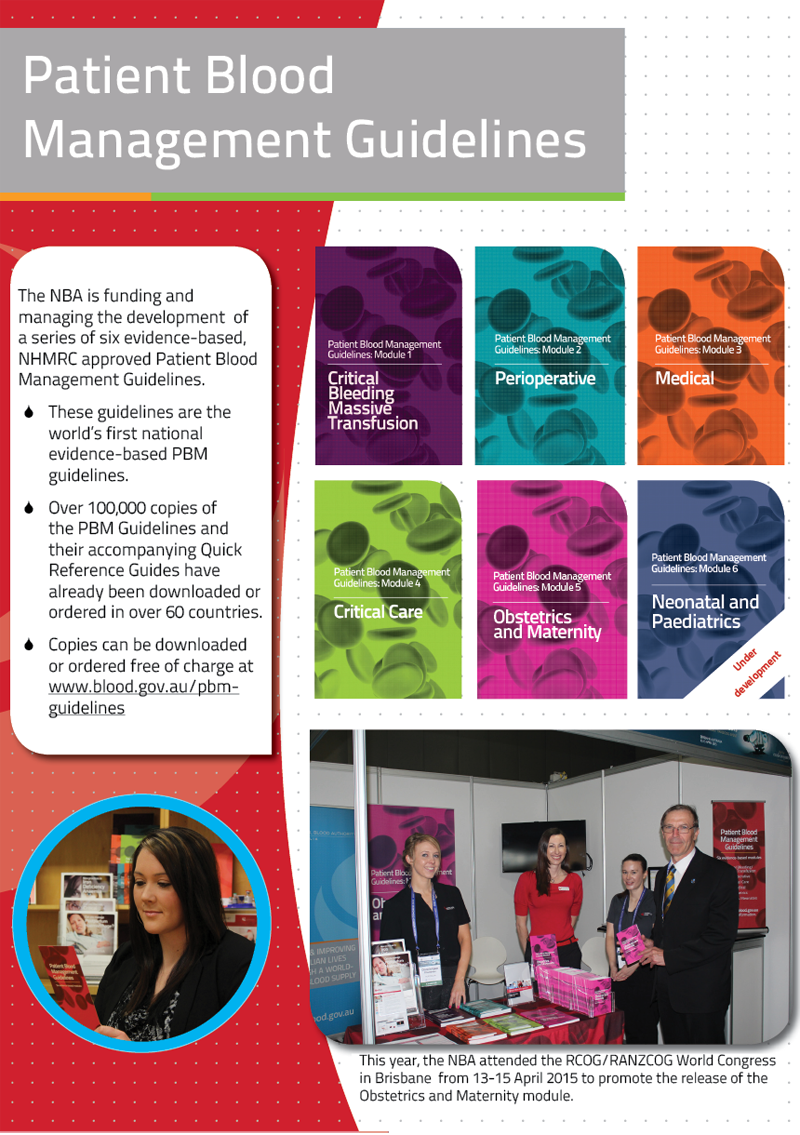
Research and Development
National Blood Sector Research and Development Priorities
Under the National Blood Agreement the NBA is charged '...to facilitate and fund appropriate research, policy development or other action in relation to new developments by relevant government or non-government persons or bodies'. In 2014-15 the JBC considered a first pass proposal to establish a research and funding facility to meet this requirement. The proposal builds on the JBC approved National Blood Research and Development Strategic Priorities 2013-2016. JBC is expected to consider the detailed business case in September 2015.
The NBA continued its partnership with the Transfusion Outcomes Research Collaborative (TORC) in relation to a project to improve outcomes for patients with critical haemorrhage requiring massive transfusion. The project is consistent with the national research and development strategic priorities in that it seeks to:
- systematically measure and monitor transfusion practice and outcomes in patients with critical bleeding requiring massive transfusion. This will be achieved using data generated by the bi-national expansion of the Massive Transfusion Registry (MTR), which has already been successfully piloted at six Australian sites
- provide robust national data on blood utilisation for massive transfusion to inform blood supply planning and inventory management and thereby improve equity of access to blood products
- inform development of future clinical studies of patients with critical bleeding and provide a mechanism to support and measure translation of new findings into practice.
Change day – do something better together!
The Australian Safety and Quality Goal 3 - Partnering with Consumers suggests that government organisations champion the involvement of consumers in governance processes and embed consumer centred principles and approaches into health initiatives to improve health services, and therefore improve patient outcomes. The NBA aims to raise awareness of patient blood management and foster a meaningful partnership with consumers in order to achieve this goal.

Change Day is a social movement that encourages people to make a pledge for change in health, aged and community care in Australia. On 11 March 2015, NBA staff participated in Change Day to support this movement by making a pledge to reduce unnecessary transfusions. The NBA's 'pledge pic' and following pledge appeared on the Change Day website: "The National Blood Authority is pledging to engage consumers and health care professionals to raise awareness of patient blood management in 2015. We pledge to help doctors and patients understand that PBM is about better management of your own blood which can reduce the amount of donated blood you receive or avoid an unnecessary transfusion. Whilst in some instances, blood can be life-saving, decisions about transfusion should include the full range of available therapies, balancing the evidence for benefits against the potential risks."
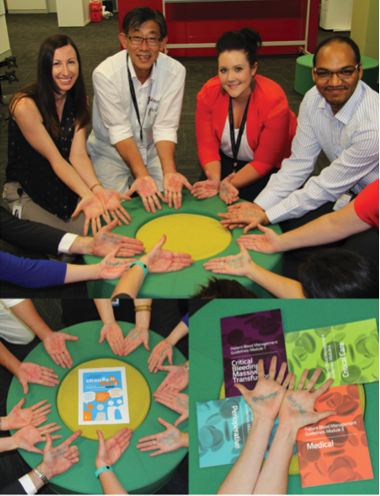
NBA staff participating in Change Day

